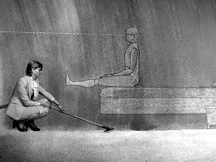- MAIN INDEX | ARTIST INDEX
| July 24 - August 18, 1984 Marsha Kennedy
| |

Marsha Kennedy, detail, pencil and charcoal on paper, 1984. Photo Peter MacCallum. 18K | |
| PRESS RELEASE This exhibition features works from two recent series of drawings by Toronto artist Marsha Kennedy. Both series reflect a concern with various opposing emotional and psychological states, concentrating on the themes of alienation, emotionality, detachment, isolation, hope and despair. The series of monochrome photo collage drawings on exhibit focus on the central figure of a working woman, depicted in numerous environments. Conceived of as the anti-hero or victim who attempts to uphold and maintain personal notions of self, achievement and success, she is contrasted in type by the inclusion of other more mechanical figures, who metaphorically represent social standards and the mechanisation of habits, thoughts and values. The second series of drawings continue the visual themes employed by the monochrome works. These drawings are more colourful, spontaneous, and emotionally based works, in which the graphic elements are selected for their emotional and associative qualities. Marsha Kennedy was born in Regina, Saskatchewan in 1951, and received an M.F.A. from York University in 1981. She has participated in group exhibitions in Regina, Toronto and Stratford, Ontario, with solo exhibitions at the Norman MacKenzie Art Gallery in Regina, and the Founder's Art Gallery, York University, Toronto. Marsha has taught at various educational institutions in Saskatchewan and Ontario since 1977, and is currently residing in Toronto.
Marsha Kennedy The Art Post, September/October 1984 With Marsha Kennedy's mixed-media drawings in Mercer Union's West Gallery from July 28 to August 18, a serious young local talent emerged into the limelight. Kennedy's intensely personal works catch the eye with their swirling movement and evocative symbolism. They also manage the notable feat of engaging viewers on an intellectual level, as well as hitting the emotional hot spot. In her black and white Woman series, a photograph of a mannishly dressed (when dressed) young woman is pasted onto surrealistic renderings of oh-so normal environments: the bedroom, the office, the dining room. She is separated by enormous distances from other elements in the scene - the figures are roughly 5" tall on a 5' wide drawing surface. All other characters are rendered in schematic outline, as is the furniture, see-through and two dimensional. On a plane behind the "action," however, are cosmic back drops, indicating the movements of energies far greater than the fore ground figures ever suspect. The relationship between the two levels seems broken, indistinct. This disassociation is echoed in the foreground. A long table separates the woman from her dining partner. On a visit to the hospital, she is separated from the patient's bed by a deep trench. She is caught in her roles like a mouse in an endless maze, going from one to the other dutifully, but with little understanding. Once, she looks out at the viewer in boredom, perhaps for an answer. We can only encourage her to look behind her at the marvellous skies - one is copped directly from Van Gogh's Starry Night - for only then will there be any chance for enlightenment. Another series, this one of birth related images, one of which was in the Mercer show, was seen as part of a group show at the Pauline McGibbon Cultural Centre June 27 to July 21st. The swirling backdrops of the earlier series are the element here, coloured in rich earthy tones, and the images again are anything but simple. In one of them, an embryo (unabashededly borrowed from da Vinci's notebooks) floats safely down a lighted corridor towards ... a table lamp. Icons such as a chair, a tea cup, a house and a bird recur from one piece to the next, either at centre stage or etched somewhere in a corner. They were executed shortly after her father's death, and not surprisingly express a longing for security and an instinct for life. But at the same time they evoke the whirlwind, chaos, and point to forces which could as easily destroy life as create it.
| |